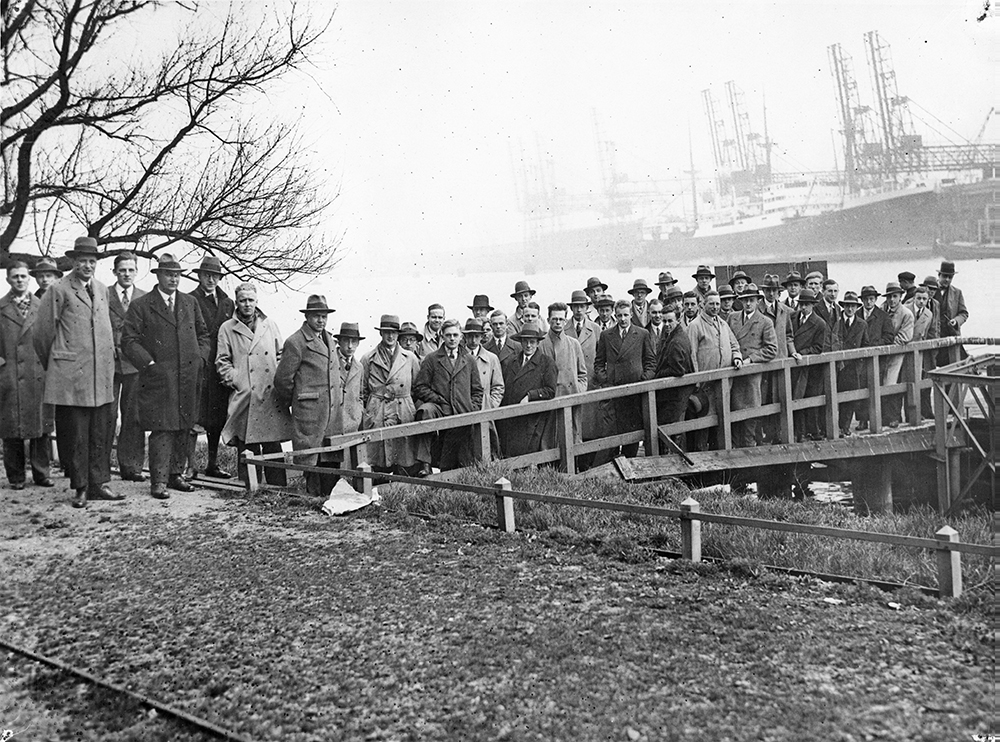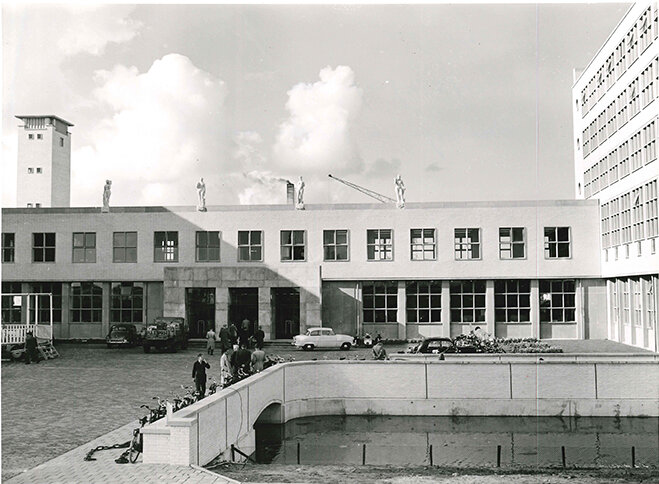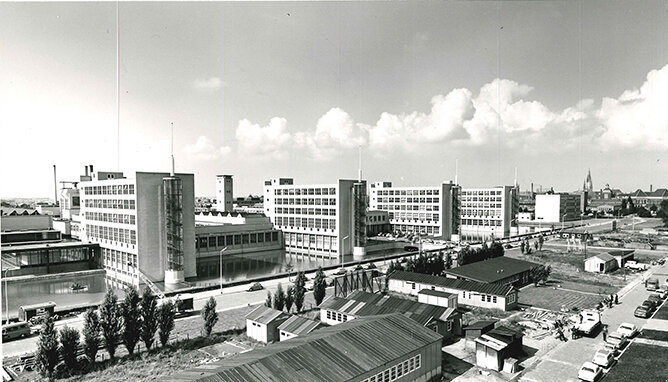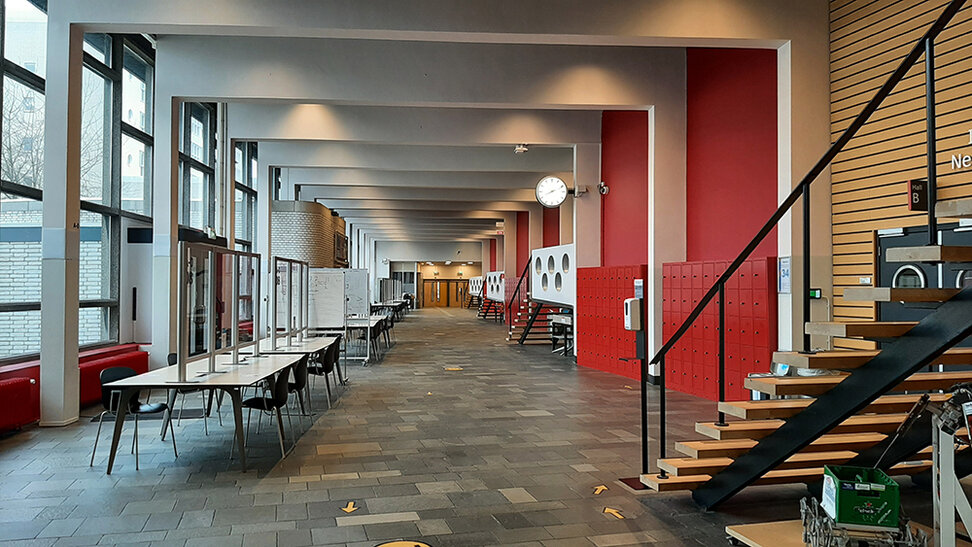
160 jaar

1864 - 1910
1864 – The Department of Mechanical Engineering and Shipbuilding is established
In 1864, the 'Koninklijke Academie' (Royal Academy) in Delft was changed into the 'Polytechnische School'. In September that year, the Department of Mechanical and Maritime Engineering was established.
The department then had nine students: eight for mechanical engineering and one for maritime engineering. The tuition fee back then was ƒ 200,---
Civil Engineer Adrien Huet became a teacher of mechanical engineering at the Polytechnische School. He started teaching mechanical engineering in 1864 in two small upper classrooms on the Westvest with the eight students who had enrolled to study Mechanical Engineering. In doing so, he had big ambitions: not only did he want to establish an academic study, he wanted the engineers who completed his studies to be informed about a wide range of discliplines!
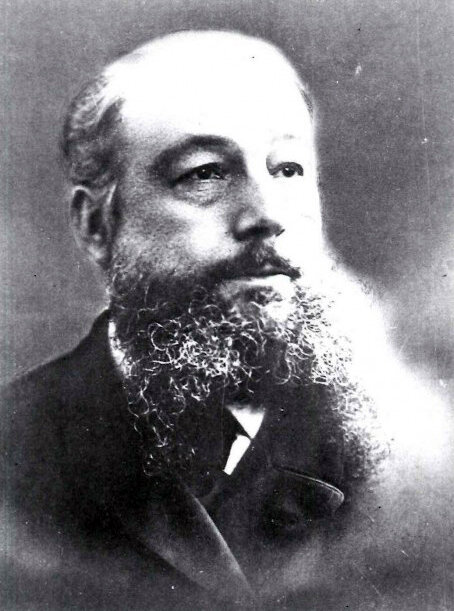
A. Huet (1836 - 1899)
Teacher mechanical engineering at the Polytechnische School (1864 - 1899, became professor at 1896).
1867 – Gezelschap Leeghwater is established
Adrien Huet encouraged students to establish a mechanical engineering student association, named after Jan Adriaenszoon Leeghwater, a carpenter who assisted in the reclamation of polders.
The association arranged guest lectures, often in preparation for field trips. Professors Huet and Ravenek arranged for students to visit a number of industrial facilities, including factories, steam pumping stations and shipyards. One of Leeghwater’s key tasks was to maintain contact with professors on educational matters.
1890 - Growing number of Mechanical Engineers
For the first 15 years of the Polytechnische School, the number of mechanical engineering students remained small. After 1890, it entered a growth phase that continued until 1920. In the short period 1895-1905, 259 engineers graduated in mechanical engineering, compared to less than 200 in the subsequent 32 years.
This is partly because the industrial revolution also broke through in the Netherlands around that time. Steam engines became more sophisticated, and more mobile, giving them more and more applications. Steam became a generally applicable power source; in the textile industry, in printing, in utilities and in the food industry. The operation of railways and tramways, large shipping companies and industrial activities created high demand for Dutch products, maintenance people and constructors.
1903 – Scheepbouwkundig Gezelschap William Froude is established
To give shipbuilding in Delft an ‘initial semblance of autonomy’, three students founded the student association for naval architecture and maritime engineering: Scheepbouwkundig Gezelschap William Froude.
The association was named in honour of the engineer, hydrodynamicist and shipbuilder William Froude. The association’s objectives were to publish written material and organise lectures and excursions, to strengthen links with industry and to improve facilities for students.
1905 - Academic level Polytechnische School
The Polytechnische School did not have an academic level yet. In 1905, the Delft college was then elevated to Technische Hogeschool.
The grand opening by Queen Wilhelmina took place on 10 July in 'de Stadsdoelen'. The first Rector Magnificus was Ir. J. Kraus, professor of hydraulic engineering.
1905 - The first full-time professor in maritime engineering
H. Cop became the first full-time professor of maritime engineering, in which he had already taught since 1888 at the Polytechnische School.
Shipbuilding was initially taught at the Koninklijke Academie by retired naval officers, who until about 1900 never attracted more than two students a year - mostly from shipping families.

H. Cop
The first full-time professor Maritime Engineering in Delft

1911 - 1954
1911 – The move to Nieuwelaan 76
In 1911, the Mechanical Engineering and Shipbuilding building was constructed on Nieuwelaan.
It consisted of a main building with three wings. In addition, a separate area was constructed for the storage of ship models and a shipbuilding laboratory. The west wing housed the mechanical engineering laboratory with three laboratory halls. These facilities contained the main types of machinery, including steam boilers, pumps, steam turbines, marine steam engines, cooling machines, measuring devices and testing installations.








1921 – First female mechanical engineer
In June 1921, a century ago, Stanny Koopman became the first woman to graduate in mechanical engineering.
Stanny Koopman came to the Technische Hoogeschool in Delft in 1915 to study mechanical engineering. Later, she also taught mathematics and mechanics.
In 1959, she was invited to present the engineering diploma to Diny Lammens, the second female mechanical engineer.

Stanny Koopman
The first female Mechanical Engineer in Delft
1945 - Engineers after the liberation
After the liberation, the same desire prevailed in the Dutch industry, at the Technische Hogeschool and at the Department of Mechanical, Maritime and Aerospace Engineering: get to work.
The Netherlands needed engineers and, given the importance of industry at the time, they should be mainly mechanical engineers. The number of students in the department stabilised at around 1,500. That was a threefold increase from before the war, and a number equal to that of the total student population at the start of the TH in 1905.
Now, the situation was not such that an energetic start could be made immediately. The buildings in Delft had been looted, money and currency to buy new equipment were lacking. Students were there, but teachers were harder to find.

1955 - 1989
1955 – New location for Mechanical Engineering on Mekelweg
In 1955, the Department of Mechanical Engineering, which had been located at Nieuwelaan 76 since 1911, moved to Mekelweg 2.
Architect Ad van der Steur designed the building together with Herman de Groot and Klaas Ruige. The four tall educational buildings are held together by a low intermediate building and surrounded by water. Emergency stairs in glass cylinders shoot up at the heads. Geert Drexhage is the architect of the wing with the lecture halls. The building is an example of reconstruction architecture and is today a national monument. Parts of the building were completed and delivered between 1953 and 1957.
Above the entrance to the building are four sculptures of women representing the elements, made in 1955 by Leen Blom, Dirk Bus, Cor van Kralingen and Bram Roth. These allegorical statues represent the elements of water, fire, air and earth and are made of limestone. Artist Bram Roth remembers that they carved the statues on the roof, under a tarpaulin for protection from the rain.
From left to right:
- Water with water jug and cloth, keystone sun-waves by Leen Blom.
- Fire with torch, keystone lightning bolt by Dirk Bus
- Sky with bird, keystone flying bird by Bram Roth
- Earth with corn and bunch of grapes, keystone salamander by Cor van Kralingen.
1961 - Grande Spirale
The sculpture Grande Spirale, created by Marta Pan in 1960, consisted of a spiral shape and balanced on an aluminium column.
The work was officially unveiled on 29 May 1961. For the first few years, it stood in front of the Mechanical Engineering and Shipbuilding Building, where it was prone to being moved by the wind. Indeed, strong winds sometimes dislodged the Grande Spirale from its axis, so the artwork had to be removed from the pond. It was relocated to the new Aula in 1966.
1970 – Student protests
There were protests against the shortening of the study duration and higher tuition fees, and for the democratisation of education. In 1975, there were also protests against the (temporary) freeze in the number of students in Delft.
1970 – Previously highly experimental research is replaced by computer simulation studies
From 1970 onwards, computers entered the workplace, research, teaching and organisation. The 1970 education report proudly announced that the examination programme had reached ‘full computer readiness’. At the time, this simply meant that exams were being processed by computers.

1990 - 2024
1994 – The Mechanical Engineering design competition is launched
The first design competition, called the Leeghwater Design Competition, was held in 1994. The inspiration for the contest was an idea by professors J.C. Cool and K. van der Werff. Initially, senior Mechanical Engineering students participated and were rewarded with cash prizes and study credits.
In 1997, an experimental design competition was organised for first-year students, not as a competition but as a demonstration during the lunch break. The Director of Education, H. Klein Woud, found it to be such a great success that he decided to make the competition a compulsory part of the first-year Mechanical Engineering curriculum for the 1997-1998 academic year.
1997 – Integrated Design, Construction and Production (OCP) faculty
The Faculty of Mechanical and Maritime Engineering was merged with the Faculty of Industrial Design in 1997. The name of the new faculty was: Design, Construction and Production (OCP – Ontwerp, Constructie en Productie). In 2004, Industrial Design became an independent faculty again. In 2006, the Faculty of Materials Science was integrated into the faculty and give the new name 3mE: Mechanical, Maritime & Materials Engineering.
1999 – Major renovation of the faculty building
The faculty continued to grow, and in 1999 the faculty’s board was faced with an important choice: renovate the current building or move to a new one. The decision was made to renovate the current building on Mekelweg.
Additional space was created by adding a glass wall to the outside of the front façade, for example. During the renovation, colleagues temporarily worked in tents behind the building. They were occasionally surprised by insects in the meeting room.
2001 - Jenny Dankelman first full-time female professor
In 2001, Jenny Dankelman became a professor of Minimally Invasive Technology.
Since 2007, Professor Dankelman has been head of the Minimally Invasive Surgery and Interventional Techniques (MISIT) group. At MISIT, Professor Dankelman focuses on improving minimally invasive surgery, flexible endoscopy, needle- and endovascular interventions.

Jenny Dankelman
First full time female professor at Mechanical Engineering in Delft.
2014 - New BSc Klinische Technologie
With the start of the new academic year 2014-2015, the first batch of students started the bachelor's programme in Klinische Technologie. This new programme at the interface of medicine and engineering is a unique collaboration between TU Delft, Leiden University, Erasmus University Rotterdam, and the university medical centres in Leiden and Rotterdam.
2014 – S.V.K.T. Variscopic is established
Variscopic is the student association of the BSc Clinical Technology and the MSc Technical Medicine.
The name was coined by Clinical Technology students during their induction weekend. The name Variscopic is a portmanteau derived from the words ‘Varius’ (different) and ‘Scopeo’ (to observe). This name was chosen because the students approach the medical and technological worlds in diverse ways and bring these disciplines together.
2018 - Leeghwater elephant
Symbolising the 150th anniversary of the oldest study association in the Netherlands.
The project came about in collaboration with Japanese artist Kouji Ohno. He worked side by side with the students for this. Land Art Delft, the art landscape park created from a collaboration between TU Delft and the World Art Delft foundation, was also closely involved. The artwork is made of materials donated from the technical sector; from the medical world to the offshore industry.
2020 – Covid-19 pandemic
During the lockdowns of the Covid-19 pandemic from 2020 to 2022, the faculty organised the research and teaching activities under the motto ‘online where possible, and on campus where it adds significant value’.
Courses that focused on knowledge transfer were conducted online. Practical education took place at the faculty in a limited and regulated manner. By observing regulations and using tools such as splash screens and barrier tape, it was possible to work on campus when necessary.
2020 – Visit by Mark Rutte during the Covid-19 pandemic
During the lockdown in April 2020, Prime Minister Mark Rutte visited projects by the Air for All initiative, including the Inspiration project.
BioMechanical Engineering researchers designed a mechanical respirator that is easy to build and repair, using only parts that are readily available in less developed countries. Working drawings and assembly instructions were distributed free of charge.
2024 – Name change to Mechanical Engineering
The Faculty of Mechanical, Maritime and Materials Engineering (3mE) changed its name to Mechanical Engineering, ME for short, on 1 January 2024. With this name, the faculty has returned to the basis that connects all the disciplines within the faculty.
A special thanks to Abel Streefland, Paul Breedveld, Jenny Dankelman and Paul van Woerkom for helping to create the timeline.
Do you have questions or comments about the timeline? Please contact communication-ME@tudelft.nl.
![[Translate to English:] Logo van de faculteit Mechanical Engineering](https://filelist.tudelft.nl/me/Organisatie/Over%20de%20faculteit/extensie-ME-cmyk.png)




